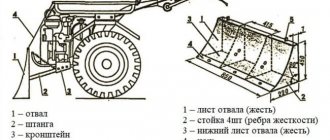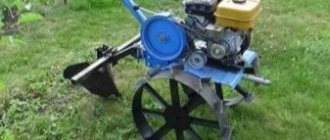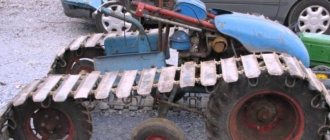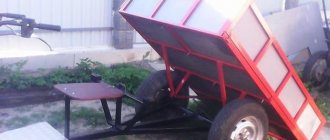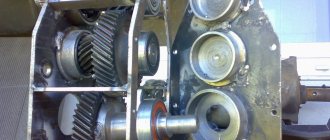Wheels for walk-behind tractor - varieties, manufacturing, video
Wheels for a walk-behind tractor are one of its most important components. The cross-country ability, maneuverability and functionality of the walk-behind tractor as a whole will depend on their quality, size and variety.
In order to decide on the optimal choice of wheels for a walk-behind tractor, before purchasing or manufacturing them, you should familiarize yourself with their varieties and features.
Traction wheels
Designed for use of walk-behind tractors in different conditions. They will cope perfectly with the load when transporting heavy objects, and are simply useful for driving on roads and flat surfaces.
Thanks to the special herringbone tread pattern, pneumatic traction wheels can also be easily used for heavier work - plowing, cultivating, hilling, etc. This type of tread allows you to work on sticky or loose soil without much difficulty, without fear of that the unit will get stuck.
Typically, this type of wheel has fairly wide tires (more than 20 cm) and a large rim diameter (40 cm or more).
Special types of traction wheels for walk-behind tractors are solid and lug wheels.
Solid wheels are characterized by increased strength and a more powerful tread.
Lugs are a special type of wheel, consisting of steel rims and special teeth, which are shaped like the same herringbone tread. Although this type of wheel is not large, its weight and design allow it to perform work even on the most difficult soils.
Twin wheels
The design of these wheels from a walk-behind tractor involves connecting (pairing) together two identical rims and placing these devices on both sides of the unit.
This type of tires for walk-behind tractors significantly increases the cross-country ability of the walk-behind tractor, eliminates the risk of slipping and overturning of equipment, and increases speed on a flat surface.
Support wheel
A special type of wheel attached to the walk-behind tractor is responsible for reducing the load on the operator, taking on the load from the motor and the entire body of the unit. Despite its small size, it is also useful in that it increases the stability of the walk-behind tractor when not in use and makes it easier to transport.
The design of many modern models of walk-behind tractors provides such a wheel or support foot, which is also very convenient.
Wheel extensions for walk-behind tractor
In order to increase the track width, make the walk-behind tractor more stable and durable, you can make such a simple device as wheel extensions.
You can make this device with your own hands using the following algorithm:
- Buy 2 metal pipes. Their diameter should be approximately 1 - 1.5 mm smaller than the diameter of the axle.
- To attach the pipe to the axle, cut a thread and screw the extension to the walk-behind tractor.
- The other end of the pipe must be adjusted as closely as possible to the hole in the disks. If necessary, the product can be sharpened. If, after adjusting the extension cord, there are gaps between it and the disk, debris and dirt will clog in them, which will negatively affect the operation of the walk-behind tractor.
- Steel plates are bolted to the disk, which will connect the extension to the disks.
We invite you to watch the video, which shows in detail the process of manufacturing an extension for the walk-behind tractor axle:
DIY walk-behind tractor wheels
Making wheels for a walk-behind tractor yourself is not such a difficult task. It is important to have only suitable blanks and tools. Old motorcycle wheels are ideal as blanks. You can also construct wheels for a walk-behind tractor from car rims.
You should take into account the dimensions in advance - the wheels should be wide enough and massive, with good tread, about 20 inches in diameter. Also take care of an extension cord to increase the track width (the process of making an extension cord is described in the previous section).
Making homemade wheels from car rims should be done according to the following algorithm:
- Take 4 disks from the car. Their sizes must match exactly.
- Sand the discs with a file, clearing them of burrs and chips.
- Weld the discs to each other with the convex side.
- Put pre-selected tires for a walk-behind tractor on these blanks, inflate them and attach them to the axle.
The manufacturing process for twin wheels is the same, with one small difference. Between the future paired wheels you need to weld a square of appropriate sizes, welded from strips of metal.
Wheels made in this way are ideal for walk-behind tractors of the Neva, Agro, Krot and other well-known manufacturers.
Source: https://pro-traktor.ru/motobloki/kolesa-izgotovlenie.html
Metal with lugs
Such wheels have a certain weight, so they have additional power.
Steel teeth “push” the unit forward and do not allow it to load even in the most clay soil. Particular attention must be paid to the support front wheel, which bears a considerable load. It helps to optimize land work and increase the endurance of the walk-behind tractor itself.
Trailer wheels have a similar classification and are selected according to the same principles. Do not forget that in the process of transporting heavy loads, low pressure is applied to the wheels of the walk-behind tractor itself, and high pressure is applied to the wheels of the cart (trailer). Therefore, in this case you need to choose the most durable options.
Homemade wheels for a walk-behind tractor with your own hands
Wheels for walk-behind tractors have various options. To create it yourself, before making wheels for a walk-behind tractor, you will need to calculate all the required dimensions, since different classes of equipment have their own technical characteristics.
Homemade wheels for a walk-behind tractor with your own hands can be either solid metal or iron, or pneumatic, including those removed from Lada cars. It all depends on the purpose of the equipment and its use.
Save your money by creating wheels for your walk-behind tractor yourself
On 4 wheels
The 4 wheels can be installed in different ways on the device. The first option is to transform the equipment into a mini-tractor and equip it with a seat. The second option is more common when making homemade equipment. In this case, and the use of unsuitable machine or motorcycle parts, two identical pairs are paired with each other.
Standard conversion of equipment into a mini-tractor is a common procedure if the unit has sufficient power. For this process, a free axis is created, which is installed on an elongated body. Paired equipment is placed on this axis.
When using the paired version, two sibling pairs are broken up and paired with the second wheel. It is also possible to install weighting agents between adjacent disks, but in homemade work, most often the disks are paired with a small gap using a small rectangular window, which then serves as a weighting agent.
Important! Paired options can be either solid rubber or pneumatic, but one pair must have an aggressive tread.
When fully created, each part will be a double element, which is created from equal parts. It turns out that the elements must be the same in shape and size.
Among the advantages of this design:
- higher level of productivity;
- quick removal of external parts;
- ease of creation;
- high level of contact with the surface.
The main advantages are increased maneuverability and increased speed.
A walk-behind tractor with 4 wheels is considered the most practical for creating at home.
Single wheel
A one-wheel motor cultivator is considered one of the simplest options for doing it yourself. One device can be both a pneumatic traction and a grouser.
This type of equipment is used for carrying out simple agricultural work, for example, hilling or digging potatoes.
One device is installed on the walk-behind tractor, which is also a support device.
During operation, significant pressure is exerted on the support area, which requires its large size. If the element on a one-wheel walk-behind tractor has a small diameter, then problems with maneuverability may arise, even in good soil conditions.
How to install Zhiguli wheels
If you have old spare parts for Lada cars, then there are two options for using them. The first is the creation of lug elements based on discs. This procedure requires the following steps:
- remove and clean the disks;
- weld the plates in a certain order, which will act as lugs;
- install lugs using weights and extensions on the base.
If you use pneumatic tires from Zhiguli, then it is advisable to install winter tires on the walk-behind tractor, which are more aggressive and have greater cross-country ability. If the walk-behind tractor is used for large-area work, then it is necessary to use a paired version or lengthen the axle when installing parts from Zhiguli.
Pneumatic wheels for walk-behind tractor
Pneumatic wheels are used in various models of equipment. This is possible due to the presence of high permeability on any type of soil. Among the features of pneumatic tires are:
- Christmas tree protector;
- sufficient width;
- standard dimensions are 20 cm in width and 40 cm in diameter;
- Large size facilitates use over large areas.
Important! Pneumatic options may be different, but if available, it is better to use those with a more aggressive tread type.
When choosing sizes, you also need to pay attention to the technical characteristics of the walk-behind tractor itself. Each type of model has its own characteristics that need to be taken into account.
Independent creation of equipment for machinery depends on numerous factors, including the availability of parts and the required tools. If necessary, you can use old wheels from cars or motorcycles.
The main condition is suitable dimensions for the walk-behind tractor class. The entire process is carried out in accordance with a sequential order of actions, that is, first the preparation of materials occurs, then drawing up a drawing, if necessary, and taking measurements.
Only after this you need to start working independently.
Source: https://vsemotobloki.com/motobloki/kolesa-k-motobloku.html
How to install car wheels on a walk-behind tractor?
In general, the process of installing disks from a passenger car to a walk-behind tractor is simple and does not take much time. To work, you need wrenches 12 or 13 (depending on what bolts are used to secure the “original” disks on the device), and 17. You will also need a drill.
Passenger car wheels are placed on the hubs with the inside out. For fastening, you should select bolts with a reserve length. This is necessary in order to be able to put additional brake discs on them for greater weight. There is no need to fix them on a permanent basis. It’s better to just carry it with you and wear it as needed. This is just an additional measure to improve cross-country ability and slightly increase traction.
Installing wider wheels will have a positive effect on the operation of the unit and will allow it to be used many times more efficiently. The agricultural device will become more resistant to all kinds of weather conditions. It will be easier to use in autumn or winter.
Wheels for walk-behind tractor - types, extensions, manufacturing
Wheels for a walk-behind tractor are responsible for the maneuverability and maneuverability of the vehicle. When mini-units are constantly used in difficult conditions, even the most reliable and high-quality wheels become unusable.
You don't always need to spend money on new parts. It is quite possible to make wheels for a walk-behind tractor yourself.
Types of wheels for walk-behind tractors
The walk-behind tractor is a multifunctional agricultural machinery. For high performance, all parts and systems must be in good working order. Otherwise, the technology will not cope with the assigned tasks. A special role in this regard is given to equipped wheels.
Depending on the design characteristics, wheels on a walk-behind tractor are divided into the following types:
- traction;
- supporting;
- solid rubber;
- metal type with lugs;
- paired.
Each type of wheel allows you to solve different problems. By using special components, you can significantly increase the performance of a walk-behind tractor and make it as stable as possible.
Solid wheels
The wheels from the walk-behind tractor are solid rubber with an aggressive tread pattern. This feature allows them to be installed also on mini-tractors.
Due to their fairly large size, these wheels are most often used in difficult terrain, wooded and mountainous areas.
Metal wheels with lugs
This type of wheel is quite small in size. But the power and endurance of the unit is ensured by the presence of weighting materials.
https://www.youtube.com/watch?v=J2oasuNqFwU
The design also includes steel teeth. Their task is to push the walk-behind tractor forward, preventing slipping even in the smallest area.
Twin wheels
These wheels have two parts, they have the same dimensions and shapes. Thanks to their design, they provide excellent maneuverability of the walk-behind tractor on uneven surfaces and significantly increase its speed on a flat road.
With such wheels, slipping is practically eliminated. That's why they are often installed during winter.
How to make extension cords?
- Prepare two pipes with a diameter two millimeters larger than the size of the unit axis;
- Make a thread for screwing extensions onto the axle;
- On the back side of the pipe there should be holes two millimeters thinner than the holes in the wheel rims.
If necessary, the pipes are cut; - The wheels are fixed to the extensions using steel plates and secured with bolts.
Wheel extensions are installed on the output shafts of walk-behind tractors.
During installation, it is checked how reliable the fastening and tightness of fixation is.
Making wheels for a walk-behind tractor with your own hands
It is impossible to make wheels for walk-behind tractors without blanks. It is necessary to prepare a basis that can be further modified and improved.
Simple recommendations for production:
- You can use motorcycle or car wheels as a base. To change the track width, special axle extensions are used. With their help, you can make wheels to implement specific tasks;
- tires for walk-behind tractors are selected for the type of soil. For sticky, uneven ground, studded tires with an aggressive tread pattern are suitable;
- homemade wheels are quite large. Otherwise they will not cope with the work. Small-diameter wheels slip, so they often have to be pulled out of wet soil;
- It is optimal to make wheels from car rims.
Work algorithm:
- Two wheels will require four rims from the car. They are cleared of burrs with a file;
- The discs are welded together with their convex sides;
- Rubber tubes are put on the prepared wheels;
- At the last stage, the wheels are inflated with air and installed on the walk-behind tractor.
To avoid any difficulties during manufacturing, it is worth watching the video.
Making twin wheels with your own hands
When using equipment in difficult conditions, you need to get dual wheels.
Double elements are made according to the following scheme:
- Treads are cut out on suitable wheels;
- Squares of 25*25 cm are welded from steel pieces and installed in the central part of the rim;
- After welding, the second rim is installed. The result should be a product that resembles a vase;
- Tires are mounted on the combined rims.
To make paired parts, you will need rims of the same size.
Manufacturing of wheels with lugs
Parts with lugs are installed on models of walk-behind tractors with a power of 6 hp or more. With. This indicator will not allow the engine to overheat under increased loads.
You need to acquire the following elements:
- steel squares;
- car wheels without rubber;
- steel corners;
- bolts.
Prepared plates are welded to the wheels and securely fixed to the rim. The corner is cut into pieces like teeth, and they are also welded to the rim. A minimum distance of 15 cm is needed from the plates to the teeth. Afterwards, rubber tires are installed on the rim, and the manufactured wheels are attached to the axle of the walk-behind tractor.
Using the tips described above, you can independently make wheels for Neva, Agro, Krot and other well-known brands.
Source: https://sadovaja-tehnika.com/motobloki/kolesa/
Car wheels on a walk-behind tractor: installation tips
For most farmers, a walk-behind tractor is an indispensable device on the farm. Its versatility allows you to simplify many jobs on land. However, modern models are equipped with wheels that are not highly reliable and do not have good driving performance. Many of them are not able to fully work even for one season. The tire sidewall bursts under constant loads, and in wet weather the unit gets stuck in the mud.
And yet there is a way out. The standard disks on the device can be easily replaced with regular car ones. Anyone can do this if they take into account some nuances and follow the recommendations given below.
Homemade accessories for walk-behind tractors with your own hands: video, drawings, photos
The walk-behind tractor is an assistant in cultivating the soil, transporting goods, and harvesting crops. For these manipulations it must be equipped with additional attachments. But in the store they are expensive; a complete set is more expensive than the walk-behind tractor itself. Many craftsmen design and make homemade products for walk-behind tractors with their own hands. Articles, photos, and instructions from the Internet help with this.
Having the simplest skills in working with an angle grinder, a welding machine, or a drill, you can assemble useful homemade products from scrap materials and disused parts. Homemade structures are often made of stronger metal than purchased ones and last longer.
Homemade devices for walk-behind tractor
The necessary attachments on the farm include:
- land cultivators - plows, cutters, rippers;
- for crop care - hillers;
- rake;
- snow shovels;
- seeders, planting devices.
Rake for walk-behind tractor
Homemade rakes for a walk-behind tractor are used when preparing hay for livestock on a small farm. They are made by hand from narrow metal pipes and rods. To create a durable structure, the parts are assembled for welding.
Homemade rakes are foldable for easy transportation.
By designing the rake yourself, you can make the grip width at your discretion. The pick-up height of the rolls is adjustable. Rake rods are made for collecting hay or mown grass on the site. In the second case, both the width of the structure and the size of the teeth can be reduced.
Homemade crow's feet cutters for walk-behind tractor
Crow's feet cutters help to deeply loosen the soil and crush large clods of earth.
This device is a one-piece welded structure, so it is stronger and more durable than conventional walk-behind cultivators. The cutter qualitatively processes hard soil for sowing potatoes. It can be used to plow the ground under the snow.
The quality of plowing depends on the degree of sharpening of homemade cutters. The soil becomes lush and rises 5-10 cm if the edges of the flat cutters are sharp. They crush large and small roots, destroy harmful beetles and wireworms, and saturate the soil with oxygen.
Homemade “crow’s feet” for a standard input mount must be made with a diameter of 52 cm, a gripper of 1.25 m, and a number of beams of 30 pieces. Each beam is bolted to the coil.
Homemade plow
A homemade plow for plowing is easy to make even for a person with minimal skills in working with metal. Milling cutters are used to loosen already used soil. The plow is used to cultivate virgin soil and compacted hard soil. It has a greater margin of safety. The plow is expensive, not every summer resident can buy it, but you can try to make it yourself.
You will need a plate 4-5 mm thick and a pipe with a wall of the same thickness. The structure is attached to the frame. The main element of the device is a sharpened plate; it must be cut with a grinder in the shape of a blade. The ploughshare has the shape of an elongated flat trapezoid. We fix the pipe and assemble the structure completely. It is connected to the walk-behind tractor via a hitch.
In a separate article you can find a drawing of a plow for a walk-behind tractor.
Reversible plow
The plow of this design is a little more complicated. A rounded feather is attached to the top of the homemade product. Not only the land is plowed, but also the cut layer is dumped - when processing virgin soil, this is sometimes necessary. The complex structure of a reversible plow requires its manufacture by a professional craftsman who can calculate the exact parameters of each part.
One of the varieties of such structures is the Zykov plow. To assemble it yourself, you will need a stand with which it clings to the walk-behind tractor, the plow body itself with the ploughshare, a board for support and a curved blade for turning over the layers. The plow moldboard is made of a pipe with a diameter of 50 cm.
Blade-shovel
A walk-behind tractor can be used to level land plots for the construction of utility structures. Like a bulldozer, it can clear sidewalks and paths of dirt and snowdrifts. To make a homemade blade, you need to take a metal sheet 2 mm thick.
For strength, plates of thicker metal are welded vertically inside the blade - they will not allow the rear wall of the blade to sag. You also need the lower part of the shovel; it is lined with tin so that the bottom does not get stuck in the ground or snow.
The bottom of the shovel is placed at a right angle to the lower base.
Homemade products for a walk-behind tractor can be made with your own hands from used materials.
To make a homemade shovel you will need a metal saw, a drill and a welding machine. A 200-liter steel barrel is suitable as a material. It must be cut along the height into 3 parts and the outer two of them welded together. The metal of the barrel is thick enough to make the device durable.
Potato planter
A very popular and indispensable piece of equipment in the garden is a homemade potato planter. It has a tuber expander with a hole at the bottom and disks for burying them in the ground. The rear wheel on the inside must be covered with a plate so that the planting material does not fall under the wheel of the walk-behind tractor. The entire structure is mounted on a steel frame. The depth of its fixation is adjustable.
The bunker can be made of plywood or galvanized thin sheet. A wooden box can be painted with waterproof paint. To prevent the tubers from being damaged, the inside of the bunker is lined with rubber.
You may be interested in a do-it-yourself harrow for a walk-behind tractor.
The planting device consists of a metal tube with a diameter of 10 cm, to which a furrow opener is attached. Its height, and hence the depth of the furrow, is regulated by the vertical movement of the structure.
The furrows are sealed with discs directed towards each other at an angle. They move due to bearings. The width of the row is changed by loosening the bolts of the stepladders and moving the disks. To ensure that there are no traces left on the ground from the planter wheels, the ground can be loosened with cultivation legs welded to the frame.
The seat of a homemade sower for a walk-behind tractor is attached to a metal base frame.
Disc hiller
From scrap materials, you can assemble a convenient device for hilling vegetable crops planted in rows with your own hands.
The main elements of a homemade hanger will be two metal pot lids or disks of the same size. Their diameter is at least 50 cm. The edges of the covers or metal disks must be sharpened like cutters.
These are the main details of the hiller. Flat lids are rounded inward using a hammer.
Read more in the article about homemade hillers for walk-behind tractors.
Disks that collect soil into a roller around the stems of potatoes or other crops are mounted on a metal frame. Small wheels are welded to the bottom of it for support. It is necessary to secure the disk rods movably so that you can adjust the angle of inclination of the processing surfaces.
Source: https://MoyMotoblok.ru/samodelki/samodelki-dlya-motobloka-svoimi-rukami/
Additional designs
For the cultivator, it will be possible to build both transportation elements and additional frame parts. Thus, the unit is “reincarnated” into a small tractor. In this form, the motor cultivator can be used as an all-terrain vehicle. In this case, the wheels of the standard type with low pressure are removed and replaced with lugs (large).
How to make lugs for a walk-behind tractor yourself, photos and complete diagrams
- Why do you need do-it-yourself lugs for a walk-behind tractor?
- How to make lugs for a walk-behind tractor with your own hands
- We make lugs for the Neva walk-behind tractor with our own hands
- How to make lugs for a Centaur walk-behind tractor
- Lugs for walk-behind tractor Zubr
- Description and dimensions of lugs for walk-behind tractors
- Making lugs for the Zubr walk-behind tractor
- How to make lugs from disks for a walk-behind tractor
A walk-behind tractor can do a lot, provided you have the appropriate attachments for it. The main function of a walk-behind tractor (at any level) is tillage.
This means that the walk-behind tractor must be able to plow the ground, hill up, and possibly plant and dig up potatoes under a certain canopy.
And when plowing, you need lugs for the walk-behind tractor; you can make them with your own hands in a few hours.
Why do you need do-it-yourself lugs for a walk-behind tractor?
Of course, to a large extent the quality of work depends on the weight of the unit. You can hang all the most functional awnings only on heavy walk-behind tractors and medium-heavy devices. But the heaviness and professionalism of the walk-behind tractor is not everything.
If you have a seemingly cool unit, but don’t get the desired results, you should purchase wheels with lugs for the walk-behind tractor. You can buy, or you can make lugs for a walk-behind tractor with your own hands. It all depends on the size of the wallet, desire and directness of hands.
Standard lugs for walk-behind tractors are metal wheels with spikes that bite into the ground and connect the walk-behind tractor with the soil.
In order to make lugs for a walk-behind tractor with your own hands, you will need knowledge of the design of lugs (the drawing and diagram will seriously make this task easier for you), determine the diameter of the canopy, select the material for converting into lugs for a walk-behind tractor, and, of course, tools for working with the original material. Essentially, it's a grinder and a welding machine.
https://www.youtube.com/watch?v=OE-CglYKTkc
Before making lugs, decide on their size. The height and width of the lugs depends on the task for which you place them on the walk-behind tractor. Later we will discuss what sizes the factory lugs that you can buy in the store can be.
And also the requirements for the severity of the lugs. After all, you put on wheels with lugs in order to improve the traction of the walk-behind tractor with the ground, and for this you need a good weight of the wheels, which the walk-behind tractor itself may not have enough. The minimum weight of wheels is 20 kg. You can also add weights to the lugs if you want to get a better result or the weight of the wheels is not up to standard.
How to make lugs for a walk-behind tractor with your own hands
The simplest answer to the question of how to make lugs for a walk-behind tractor with your own hands is to take unnecessary rims from car wheels for future lugs. We need to attach an axle shaft to these disks using a welding machine, onto which we will then put bearings. Weld metal square plates to car rims. So that the edges of the plates touch the rim.
The plates then need to be screwed to the rim with bolts. Now we need to make teeth - steel hooks that will go into the ground. To do this, we need a steel plate, for example, a corner, which must be cut into pieces with a grinder and welded from them into the same teeth that are made at the factory. The resulting hooks must be placed on the wheel rim at a distance of 15 cm from each other.
There is another way to make homemade lugs. To do this, use an old gas cylinder. Cut two disks for wheel rims from the cylinder, 5-7 cm wide and 30 cm high. And then everything is the same as you would do with car wheels.
By the way, to improve the performance of wheels with lugs, you can weld another tooth to each hook on top and lengthen the teeth to 60 cm. We need to make an axle. To do this, attach a metal plate to one of the rims on which it will be placed.
As you can see, lugs can be made from any material that has the shape of a circle. The main thing is to choose the right diameter and width for the future wheel with lugs. The dimensions of the wheels are determined by the work for which they are used on the walk-behind tractor. We have already mentioned this.
We make lugs for the Neva walk-behind tractor with our own hands
Each brand of walk-behind tractor has those attachments that are better suited to its design than others. Of course, it is best to buy a universal walk-behind tractor that fits almost any canopy. For the Neva walk-behind tractor, manufacturers made wheels with lugs Ф340х110.
By design, these lugs are somewhat larger than those that we described as a homemade option. Follow the same instructions we provided above, just select different rim sizes. The height of the wheel for lugs for the Neva walk-behind tractor should be 340 mm, and the width of the homemade lug should be 110 mm.
How to make lugs for a Centaur walk-behind tractor
The lugs for the Centaur walk-behind tractor differ only in size. Above we described the dimensions that you need to focus on when converting old wheels into lugs for the Neva. Using the same scheme, you can make wheels with larger lugs. Select a wheel height of 450 mm.
The wheel width should be 110 mm, as you would do for the Neva. Such lugs are suitable for the Centaur 2060, Centaur 2090 walk-behind tractor and similar units. If you want a factory option, store-bought lugs will cost you about $30.
Lugs for walk-behind tractor bison
The Zubr walk-behind tractor is a heavy professional walk-behind tractor. It fits the best attachments available. But in order for the Bison to penetrate the ground perfectly, you need to buy or make lugs for the Bison walk-behind tractor yourself. Standard lugs that fit it are 700 mm high and 200 mm wide.
Wheels with this width can only be used on heavy walk-behind tractors, and in addition to the Zubr walk-behind tractor JRQ78 and 79, they will also fit the Centaur 1070D, Aurora 101 and Aurora 81, Zirka LX1080D and Zirka 1090 walk-behind tractors. The distance between the hooks in the factory version is 14.5 cm. The bushing of these wheels - 60 mm in diameter. They are attached to the walk-behind tractor using an additional hub.
Description and dimensions of lugs for walk-behind tractors
As we understand, the size of the lugs very much depends on the weight of the walk-behind tractor on which they are installed.
Although heavy walk-behind tractors are the most suitable for working on heavy soils and, accordingly, lugs with a greater height and width are more suitable for coupling a professional unit with virgin soil or heavily neglected lands. Also, for high complexity of work, weights are attached to the wheels.
The dimensions of the lugs vary from 310 mm to 700 mm in height, width - from 100 to 200 mm. So, for the Salut walk-behind tractor you can buy lugs of 500x100 mm, as well as 500x200 mm.
The latter will be functional in combination with a plow. You can buy the same sizes with a sand-filled weight so that the mounted plow plows the soil deeper. Although, if you have 500x200 lugs, you can make the weighting material yourself. Wheels with lugs measuring 700x130 mm are placed on a walk-behind tractor for working with hillers, potato diggers and flat cutters.
Making lugs for the Zubr walk-behind tractor
We have already told you what size wheels are put on a heavy Zubr walk-behind tractor. The Zubr JRQ78 and 79 walk-behind tractor will also easily fit 700x100 mm lugs. They are smaller in width and, in addition to heavy ones, can be used together with medium-heavy walk-behind tractors.
The same lugs for the Zubr walk-behind tractor are suitable for the Neva walk-behind tractor. It is precisely with better compatibility that lugs of this size are in great demand.
After all, you can only put 700x200 wheels on heavy units; they are intended more for processing virgin soil, and 700x100 wheels are suitable for average farm needs and you can easily save and attach them to another walk-behind tractor when your current one becomes outdated, even if it is weaker in power .
You can make it yourself with your own hands, or you can buy it in a store. 700x100 lugs will cost you about $70.
How to make lugs from disks for a walk-behind tractor
You can make the lugs you need from old car rims. You can also use wheel rims from an old engine block. Let's say you no longer need your unit. You bought yourself a new one - better and more functional.
But you don't have lugs. Do not throw away your old unit, but convert its wheels into lugs for a new walk-behind tractor in the same way as you would convert car wheels. The sequence of actions is given at the beginning of the article.
Source: https://motobloki24.ru/kak-sdelat-gruntozacepy-dlya-motobloka-svoimi-rukami-foto-opisanie-i-razmery/

